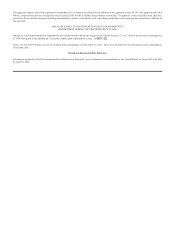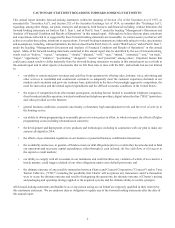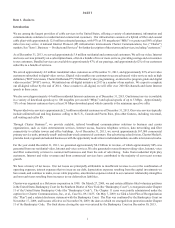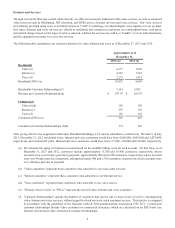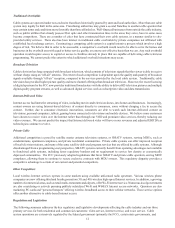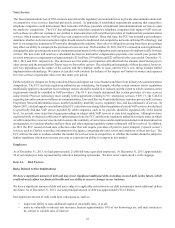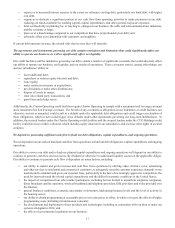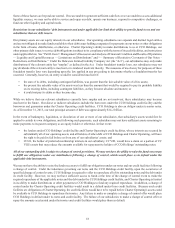Charter 2013 Annual Report Download - page 22
Download and view the complete annual report
Please find page 22 of the 2013 Charter annual report below. You can navigate through the pages in the report by either clicking on the pages listed below, or by using the keyword search tool below to find specific information within the annual report.8
Approximately 97% of our estimated passings are served by systems that have bandwidth of 550 megahertz or greater and 98%
are two-way activated as of December 31, 2013. This bandwidth capacity enables us to offer digital television, Internet services,
voice services and other advanced video services.
In 2013, we initiated a transition from analog to digital transmission of the channels we distribute which allows us to recapture
bandwidth. We completed this transition in approximately 15% of our footprint in 2013 and expect to complete the initiative in
2014 across our remaining footprint. The all-digital platform enables us to offer a larger selection of HD channels, faster Internet
speeds and better picture quality while providing greater plant security and lower transaction costs.
In 2013, we initiated a trial of a network, or “cloud,” based user interface designed to enable our customers to enjoy a common
user interface with a state-of-the-art video experience on all existing and future set-top boxes. We plan to continue to trial and
enhance this technology in 2014.
Management, Customer Care and Marketing
Our operations are centralized with our corporate office responsible for coordinating and overseeing operations including
establishing company-wide strategies, policies and procedures. Sales and marketing, network operations, field operations, customer
care, engineering, advertising sales, human resources, legal, government relations, information technology and finance are all
directed at the corporate level. Regional and local field operations are responsible for servicing customers and maintenance and
construction of outside plant.
Charter continues to focus on improving the customer experience through improvements to our customer care processes, product
offerings and the quality and reliability of our service. Our customer care centers are managed centrally. We have eight internal
customer care locations which route calls to the appropriate agents, plus several third-party call center locations that through
technology and procedures function as an integrated system. We also have two additional customer care locations acquired as
part of the acquisition of Bresnan. See “Part II. Item 7. Management’s Discussion and Analysis of Financial Condition and Results
of Operations — Overview.” We increased the portion of service calls handled by Charter employees in 2013 and intend to
continue to do so in 2014. We also utilize our website to enable our customers to view and pay their bills on-line, obtain information
regarding their account or services, and perform various equipment troubleshooting procedures. Our customers may also obtain
support through our on-line chat functionality. We increased our outside plant maintenance activities in 2012 and 2013 to improve
the reliability and technical quality of our plant to avoid repeat trouble calls, which has resulted in reductions in the number of
service-related calls to our care centers and in the number of trouble call truck rolls in 2012 and 2013.
Our marketing strategy emphasizes our bundled services through targeted direct response marketing programs to existing and
potential customers and increases awareness and value of the Charter brand. Marketing expenditures increased by $57 million,
or 14%, over the year ended December 31, 2012 to $479 million for the year ended December 31, 2013 as a result of increased
media investment and commercial marketing efforts. Our marketing organization creates and executes marketing programs
intended to increase customers, retain existing customers and cross-sell additional products to current customers. We monitor the
effectiveness of our marketing efforts, customer perception, competition, pricing, and service preferences, among other factors,
to increase our responsiveness to our customers. Our marketing organization also manages and directs several sales channels
including direct sales, on-line, outbound telemarketing and Charter stores.
Programming
General
We believe that offering a wide variety of programming influences a customer’s decision to subscribe to and retain our cable
services. We rely on our experience in programming cable systems, which includes market research, customer demographics and
local programming preferences to determine channel offerings in each of our markets. We obtain basic and premium programming
from a number of suppliers, usually pursuant to written contracts. Our programming contracts generally continue for a fixed
period of time, usually from three to eight years, and are subject to negotiated renewal. Some programming suppliers offer financial
incentives to support the launch of a channel and/or ongoing marketing support. We also negotiate volume discount pricing
structures. We have more recently negotiated for additional content rights allowing us to provide programming on-line to our
authenticated customers.
Costs
Programming is usually made available to us for a license fee, which is generally paid based on the number of customers to
whom we make such programming available. Programming costs are usually payable each month based on calculations


